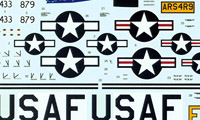7/8/2022 I've started building the Fujimi 1/24 scale model of the Porsche 917k that ran in the 1970 24 hours of Le Mans. I'm building this for my son Duke. This is my favorite race and one of my favorite race cars. Fujimi has done a great job in this kit and I'm hoping to do it justice. First – a little history about the car:

PORSCHE 917K HISTORY – Thanks to Wikipedia
In an effort to reduce the speeds at Le Mans and other fast circuits of the unlimited capacity Group 6 prototypes (such as the seven-litre Ford GT40 Mk.IV and four-litre V12 Ferrari P) the Commission Sportive Internationale (then the independent competition arm of the FIA) announced that the International Championship of Makes would be run for three-litre Group 6 prototypes for four years from 1968 through 1971. This capacity reduction would also serve to entice manufacturers who were already building three-litre Formula One engines to adapt them for endurance racing.
Well aware that few manufacturers were ready to take up the challenge immediately, the CSI also allowed the participation of five-litre Group 4 sports cars, of which a minimum of 50 units had to be manufactured. This targeted existing cars like the aging Ford GT40 Mk.I and the newer Lola T70 coupe.
In April 1968, facing few entrants in races, the CSI announced that the minimum production figure to compete in the sport category of the International Championship of Makes (later the World Sportscar Championship) was reduced from 50 to 25, starting in 1969 through the planned end of the rules in 1971. With Ferrari absent in 1968, mainly Porsche 908s and Ford P68s were entered there, with the Ford being a total failure. As a result, old 2.2-litre Porsche 907s often won that category, with John Wyer's 4.7-litre Ford GT40 Mk.I taking wins at faster tracks.
Starting in July 1968, Porsche made a surprising and expensive effort to take advantage of this rule. As they were rebuilding race cars with new chassis every race or two anyway, selling the used cars to customers, they decided to conceive, design and build 25 versions of a whole new car with 4.5-litre for the sport category with one underlying goal: to win its first overall victory in the 24 Hours of Le Mans on June 14, 1970. In only ten months the Porsche 917 was developed, based on the Porsche 908.
When Porsche was first visited by the CSI inspectors only three cars were completed, while 18 were being assembled and seven additional sets of parts were present. Porsche argued that if they assembled the cars they would then have to take them apart again to prepare the cars for racing. The inspectors refused the homologation and asked to see 25 assembled and working cars.
On March 12, 1969, a 917 was displayed at the Geneva Motor Show, painted white with a green nose and a black No. 917. Brief literature on the car detailed a cash price of DM 140,000, approximately £16,000 at period exchange rates, or the price of about ten Porsche 911s. This price did not cover the costs of development.
On April 20 Porsche's head of motorsports Ferdinand Piëch displayed 25 917s parked in front of the Porsche factory to the CSI inspectors. Piëch even offered the opportunity to drive any of the cars, which was declined.
Construction
The car was designed by chief engineer Hans Mezger under the leadership of Ferdinand Piëch and Helmuth Bott. The car was built around a very light spaceframe chassis (42 kg (93 lb)) which was permanently pressurised with gas to detect cracks in the welded structure.[7] Power came from a new 4.5-litre air-cooled engine designed by Mezger, which was a combination of two of Porsche's 2.25L flat-6 engines used in previous racing cars. The 'Type 912' engine featured a 180° flat-12 cylinder layout, twin overhead camshafts driven from centrally mounted gears and twin spark plugs fed from two distributors. The large horizontally mounted cooling fan was also driven from centrally mounted gears. The longitudinally mounted gearbox was designed to take a set of four or five gears.
To keep the car compact despite the large engine, the driving position was so far forward that the feet of the driver were beyond the front wheel axle. The car had remarkable technology. It was Porsche's first 12-cylinder engine and used many components made of titanium, magnesium and exotic alloys that had been developed for lightweight "Bergspider" hill climb racers. Other methods of weight reduction were rather simple, such as making the gear shift knob out of birch wood, some methods were not simple, such as using the tubular frame itself as oil piping to the front oil cooler.
There are at least eleven variants of the 917. The original version had a removable long tail/medium tail with active rear wing flaps, but had considerable handling problems at high speed because of significant rear lift. The handling problems were investigated at a joint test at the Österreichring by the factory engineers and their new race team partners John Wyer Engineering. After exhaustive experimentation by both groups, a shorter, more upswept tail was found to give the car more aerodynamic stability at speed. The changes were quickly adopted into the 917K for Kurzheck, or "short-tail".
In 1971, a variant of the 917K appeared with a less upswept tail and vertical fins, and featured the concave rear deck that had proved so effective on the 1970 version of the 917L. The fins kept the clean downforce-inducing air on the top of the tail and allowed the angle of the deck to be reduced, reducing the drag in direct proportion. The result was a more attractive looking car that maintained down force for less drag and higher top speed.
By this time the original 4.5-litre engine, which had produced around 520 bhp in 1969, had been enlarged through 4.9-litres (600 bhp) to 5-litres and produced a maximum of 630 bhp. The 917K models were generally used for the shorter road courses such as Sebring, Brands Hatch, Monza and Spa-Francorchamps. The big prize for Porsche however, was Le Mans. For the French circuit's long, high speed straights, the factory developed special long tail bodywork that was designed for minimum drag and thus highest maximum speed. On the car's debut in 1969, the 917L proved to be nearly uncontrollable as there was so little down force. In fact, they generated aerodynamic lift at the highest speeds. For 1970, an improved version was raced by the factory and for 1971, after very significant development in the wind tunnel, the definitive 917L was raced by both factory and JW.
In 1969 Jo Siffert raced an open-top 917PA Spyder (normally aspirated) in the 1969 CanAm series. There is also the "Pink Pig" aerodynamic research version (917/20), and the turbocharged 917/10 and 917/30 CanAm Spyders. Porsche 917s also raced in the European Interseries in various configurations. In the 1973 Can-Am series, the turbocharged version Porsche 917/30 developed 1,100 bhp (820 kW).
Racing history
1969-1971 World Sportscar Championship
1969
In testing, it soon appeared that the Porsche 917 did not work well on the race track. Porsche factory driver Brian Redman recalled that "it was incredibly unstable, using all the road at speed." Many thought that the 4.5-litre engine was too much for the frame. The suspension and the stability of the frame were suspected, but modifications did not improve the problem. It was finally determined that the "long tail" body was generating significant lift on the straights, as the 917 was 30 km/h (19 mph) faster than anything previously built for Le Mans[citation needed]. As with former underpowered Porsches, the 917 aerodynamics had been optimized for low drag in order to do well on the fast straights of Le Mans, Spa, Monza and elsewhere. The significance of downforce for racing was not yet fully realized although Can-Am and F1 cars were using wings by that time.
Before its competition debut on 11 May 1969 in the 1000km Spa, the weather conditions prevented further improvements in tests. Jo Siffert/Redman managed to clock an unofficial lap time of 3:41.9 which would have beaten the pole of 3:42.5 set by a Lola, but they chose to use the 908LH long tail with which they won the race and set the fastest lap at 3:37.1. Gerhard Mitter/Udo Schütz actually started the race from 8th, but their already ailing engine failed after one lap.
Three weeks later for the 1000km Nürburgring, all works drivers preferred the 908 over the 917 which was, despite some modifications, not suited for the twisty track. As it was necessary to promote the car in order to sell the surplus ones, Porsche asked BMW for the services of their factory drivers Hubert Hahne and Dieter Quester. They practised, but Munich declined permission to have them race, so Englishman David Piper and Australian Frank Gardner were hired on short terms. They drove the 917 to an eighth-place finish behind a Ford and an Alfa, while the factory's armada of six 908/02 spyders scored a 1-2-3-4-5 win after the only serious competition, a sole Ferrari 312P, failed.
At the 1969 24 Hours of Le Mans, the 917s were quickest in practice. Soon after the start the poor handling of the 917 and the inexperience of one of the drivers resulted in drama: British gentleman-driver John Woolfe crashed his Porsche 917 at Maison Blanche on lap 1, dying as a result. Woolfe was the first privateer to race a 917. The works #14 917 led early, but succumbed to an oil leak, while the #12 dropped out of the lead and the race in the 21st hour with a broken gearbox, despite leading by nearly 50 miles. At the end, Hans Herrmann's 908 remained as the only Porsche that could challenge for the win, but Jacky Ickx's more powerful Ford won once again, by a mere 120 metres (390 ft).
In June 1969, Enzo Ferrari sold half of his stock to FIAT, and used some of that money to build 25 cars powered by a 5-litre V12 in order to compete with the Porsche 917: the Ferrari 512 would be introduced for the 1970 season.
At that time, the 917 already had several races under its belt, yet no success. The first win came in the last race of the championship season, the 1000 km Zeltweg. Jo Siffert and Kurt Ahrens succeeded in the privately entered Porsche 917 of German Freiherr von Wendt. At that time, the factory had started to focus on development, leaving the time-consuming trips to races to customer teams.
1970
Disappointed by the poor results of the 917 in 1969, and facing new competition, Porsche concluded an agreement with John Wyer and his JWA Gulf Team, which became the official Porsche team, and also the official development partner. During tests at the Österreichring at Zeltweg, works drivers Redman and Ahrens tested the car, and the car still performed like it did before. The Österreichring was the circuit where the car had won its only race at that time, Wyer's chief engineer John Horsman noticed that the bodywork had a pattern of dead gnats dashed against it, revealing the airflow. The tail was clean—the lack of dead gnats indicated that the air was not flowing over the tail. A modification to the tail was cobbled-up on the spot in the pits with aluminium sheets taped together. This new short tail gave the 917 much needed downforce. The plastic engine intake cover had already been removed. Redman and Ahrens were doing only one lap at a time before, they each did 10 laps and were satisfied with the improved performance.[13] The new version was called 917K (Kurzheck, or "short tail").
In addition to the heavier and powerful 917, the lightweight and compact Porsche 908/3 were developed for the slow and twisty tracks of the Nürburgring and the Sicilian mountain roads used in the Targa Florio, providing wins while the factory-backed 917 remained in the garages, as these cars were not suitable for these tracks. The 908/3 was built to the FIA's 3-litre Group 6 Prototype regulations whereas the 917 was now officially a Group 5 Sports Car following another FIA review of its racing classes, applicable from 1970. Wyer was surprised to discover that another team was carefully preparing for the 1970 24 Hours of Le Mans with close support from Porsche. As in 1969, the Porsche Salzburg team was a de facto works team under control of members of the Porsche family. The Martini Racing team also gained support from Porsche AG; obviously Porsche made efforts to win the race by supporting more than one team.
Also, a new low drag version of the 917 was developed for Le Mans with support from the external consultant Robert Choulet. The 917LH (Langheck) featured a spectacular new long tail body which had very low drag, yet more rear downforce than the 1969 long tail. A 4.9-litre engine, introduced at 1000km Monza, was available but these proved to be unreliable for longer distance races.
The 917 did not compete at all the races of the season, however. Porsche's previous competition model, the 908, was redesigned with an all-new chassis and designated 908/03 so it would be used at the Targa Florio and Nurburgring 1000 km events- two twisty, narrow and slow tracks the 917 was not competitive at. Vic Elford drove a 917 during practice for the 1970 Targa Florio and it proved to be so physically demanding and difficult to drive around the circuit that he had to be lifted out of the car, although he set the 5th fastest time[citation needed]. The 908/03 was very effective at these two races. Porsche's dedication was such that they were building cars for each type of track- the 908/03 for the slow, twisty tracks, the 917K for the medium and high-speed tracks, and the 917L for the fast straights of Le Mans.
Two 917 LH were entered in Le Mans, one in white and red trim by Porsche Salzburg. Driven by Vic Elford and Kurt Ahrens, the pole sitter's 4.9-litre engine dropped an inlet valve after 225 laps. Both drivers had also been entered on the team's other car, a red and white 917 K with the 4.5-litre engine, qualified by Hans Herrmann and Richard Attwood in rather low 15th spot, but they did not drive after their own car failed.
The other LH was entered by Martini Racing, qualified by Willi Kauhsen and Gérard Larrousse on 12th position. The spectacular livery of this car was elaborate whirls and swoops of light green on a dark blue background. The car with the 4.5L engine gained the nickname of the Hippie Car or the Psychedelic Porsche from the team and media.
Early in the race, most of the works Ferrari 512 entrants eliminated each other in a shunt. The two Porsche factory teams, Gulf-Wyer and Porsche Salzburg, continued to battle each other, but all Wyer cars were out after 12 hours. At the end it was the red and white #23 917K of Porsche Salzburg, with the standard 4.5-litre engine, carefully driven by Stuttgart's own Hans Herrmann and Englishman Richard Attwood through the pouring rain, that finally scored the first overall win at Le Mans, in a wet race that saw only 7 ranked finishers. Martini's 917LH came in 2nd. Both cars were later paraded across Stuttgart. In addition to Porsche's triumphant 1, 2 victory, a Porsche 908 came in third overall, a Porsche 914-6 came in sixth overall (plus it won the GT class), and a Porsche 911S was seventh. (Two Ferrari 512s took fourth and fifth place overall.)
Towards the end of the 1970 season, Ferrari entered some races with a new version of the 512, the 512M (Modificata). The 512M had a new bodywork built on a similar aerodynamic doctrine as the Porsche 917K. At the end of 1970 the 512M was as fast as the 917s, but still lacked in reliability.
During the 1970 season the FIA announced that Group 5 Sports Cars would be limited to a 3-litre engine capacity maximum for the newly renamed World Championship of Makes in 1972, so the big 917s and 512s would have to retire from the championship at the end 1971. Surprisingly, Ferrari decided to give up any official effort with the 512 in order to prepare for the 1972 season. A new prototype, the 312 PB, was presented and entered by the factory in several races. But many 512s were still raced by private teams, most of them converted to M specification.
By the end of 1970, Porsche had stamped their authority on endurance racing by convincingly dominating the championship that year. Of the 10 races in the championship (plus some other non-championship events), the works teams (John Wyer Automotive and Porsche Salzburg) had won every race except Sebring (which was won by Ferrari) that year with the two models of cars they used, the 917K and the 908/03; with the 917K winning 7 of 8 events it was entered in; and the 908/03 winning at the Targa Florio and the Nürburgring (the 917K was not entered by the works teams at these two events). Still having some of their 25 cars remaining unsold, Ferrari offered them to customers at a bargain price – a move that had hardly been imaginable less than two years previously. For Porsche, the original production series of 25 917s could not satisfy demand. Over 50 chassis were built in total. An underdog for 20 years, Porsche had turned itself into the new leader of sports car racing with the 917.
1971
The domination of Gulf-Wyer and Martini Porsches in 1971 was overwhelming. The only potential challenger to the 917 appeared early in the season: Roger Penske had bought a used 512S chassis that was dismantled and rebuilt beyond M specification. The car was specially tuned for long races, receiving many unique features among which were a larger rear wing and an aviation-inspired quick refueling system. The engine was tuned by Can-Am V8 specialist Traco and able to deliver more than 600 hp (450 kW). Penske's initiative was not backed by Ferrari works. This 512M, painted in a blue and yellow livery, was sponsored by Sunoco and the Philadelphia Ferrari dealer Kirk F. White. Driven by Penske's lead driver Mark Donohue, it made the pole position for the 24 Hours of Daytona and finished third despite an accident that required almost an hour in the pits. For the 12 Hours of Sebring the "Sunoco" made the pole but finished the race at the sixth position after making contact with Pedro Rodríguez's 917. Despite being fastest on track on a few occasions, the 512M was not a serious contender.
The 1971 917LH.
The presence of the 512M "Sunoco", as well as the Alfa Romeo T33/3 which won Brands Hatch, the Targa Florio and Watkins Glen, forced Porsche to pursue their efforts in research and development[citation needed]: tails of the 917K and the 908/3 were modified with vertical fins, and the 917 LH aerodynamics received further improvements. New chassis made of magnesium were developed, even though this material could burn vigorously in the presence of a fire.
A heavily modified R&D car, the 917/20, was built as test-bed for future Can-Am parts and aerodynamic "low-drag" concepts. The 917/20 which had won the test race at Le Mans was painted in pink for the 24 hours race, with names of cuts of meat written in German across it in a similar fashion to a butcher's carcass diagram, earning it the nickname "Der Trüffeljäger von Zuffenhausen" (The Trufflehunter of Zuffenhausen, pigs being often utilized for locating truffles for harvest) or just plain "Pink Pig". This experimental car surprisingly qualified 7th for its only race- the 1971 Le Mans 24 Hours and ran as high as third, but during the night Reinhold Joest crashed the car at Arnage after its brakes failed. This was because the 917/20 was harder on the brakes than the K, but ran to the same brake change schedule.
And at Le Mans, once again it was not the new machinery that won. The white #22 Martini-entered 917K (chassis number 053) of Helmut Marko and Gijs van Lennep, equipped with a magnesium frame, set an overall distance record that stood until 2010 when the Audi R15 TDI of Romain Dumas, Mike Rockenfeller and Timo Bernhard set a distance record of 5,335.313 km (3,315.210 mi), an average speed of 220.2 km/h (137.6 mph).
This Porsche still holds the fastest lap at the Le Mans racing circuit to this day (3:13.6) but of course, there have been a number of fundamental changes to the circuit since 1971. Pedro Rodriquez had also set a qualifying lap record of 3:13.9, setting him at pole position in his #18 John Wyer Gulf LH car that unfortunately did not finish the race.[15] All in all, four separate Le Mans track records were broken that year: Fastest qualifying lap, fastest in-race lap, highest top speed, and longest distance covered. All were set by 917s. None of the long tail 917s finished.
Now – on to the pictures…
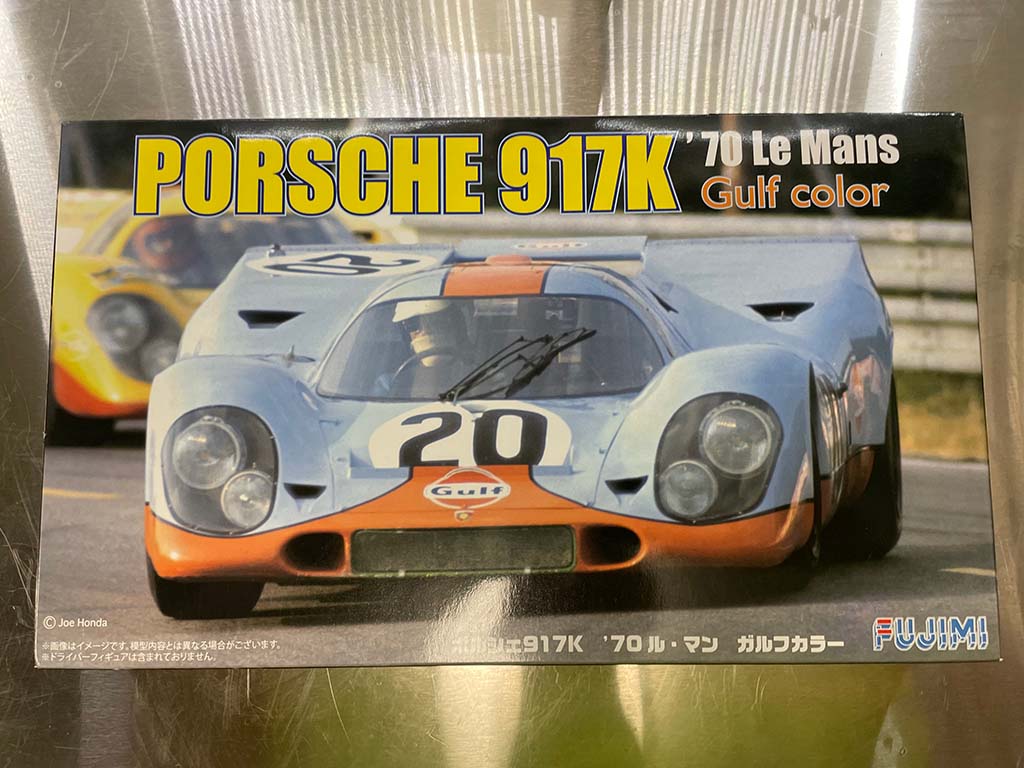







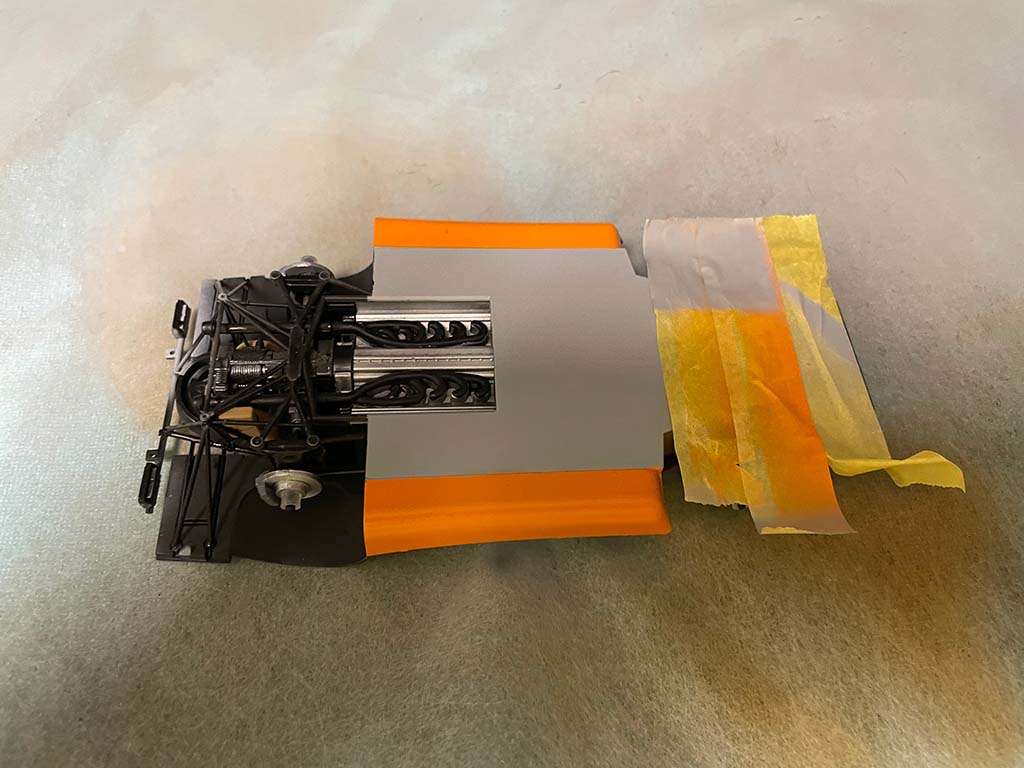

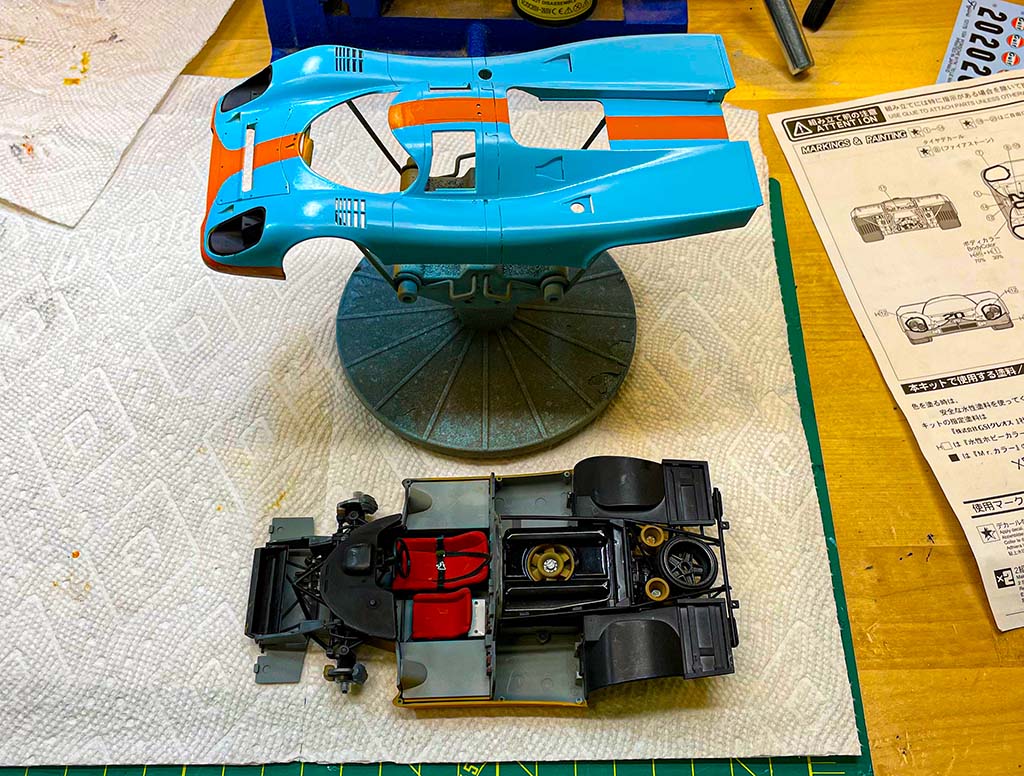
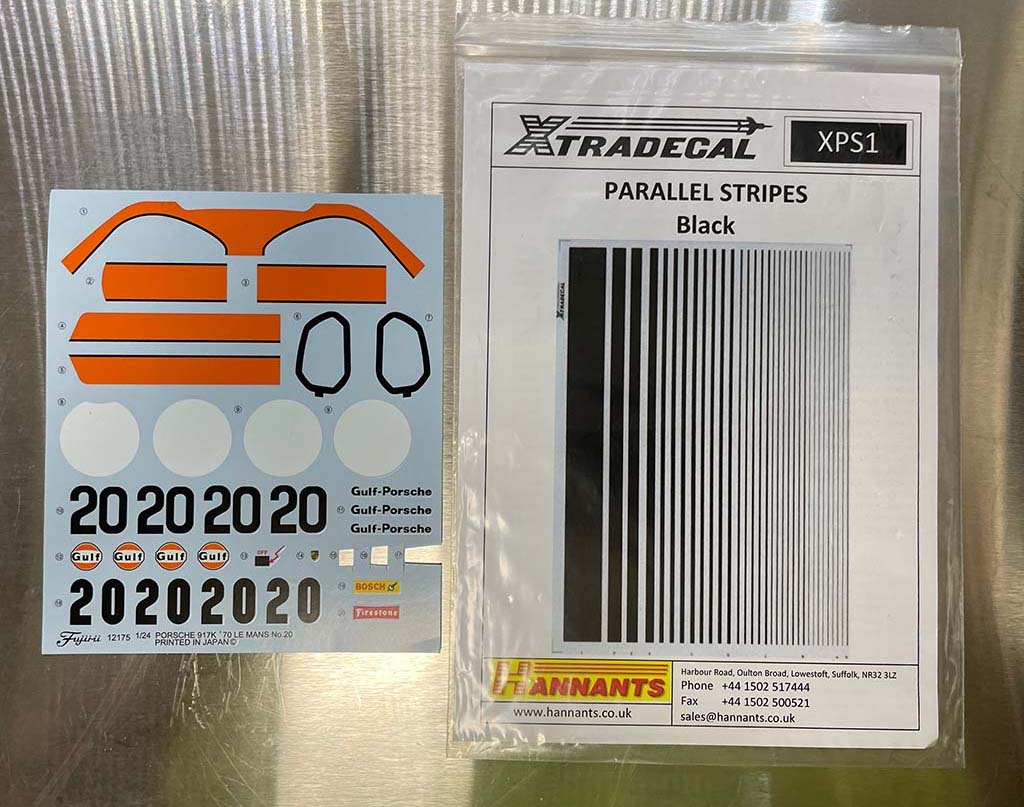
I figured that I wouldn't be able to match the orange of the decals so instead I've masked off the model to spray the onange in the correct areas. I will use the parallel stripes from Xtradecals to replicate the black stripes on the car. We'll have to wait and see if this is a good idea.
7-23-2020 The model is finished. Below are the finished pictures. It was a lot of fun to build and I think I made the correct decision to spray the orange instead of using the decals. As a final touch I used Flory's Dark Dirt weathering was by airbrushing from the font to simulate track grime. The Le Mans race is 24 hours and this is very close to what the car would look like after a few hours.






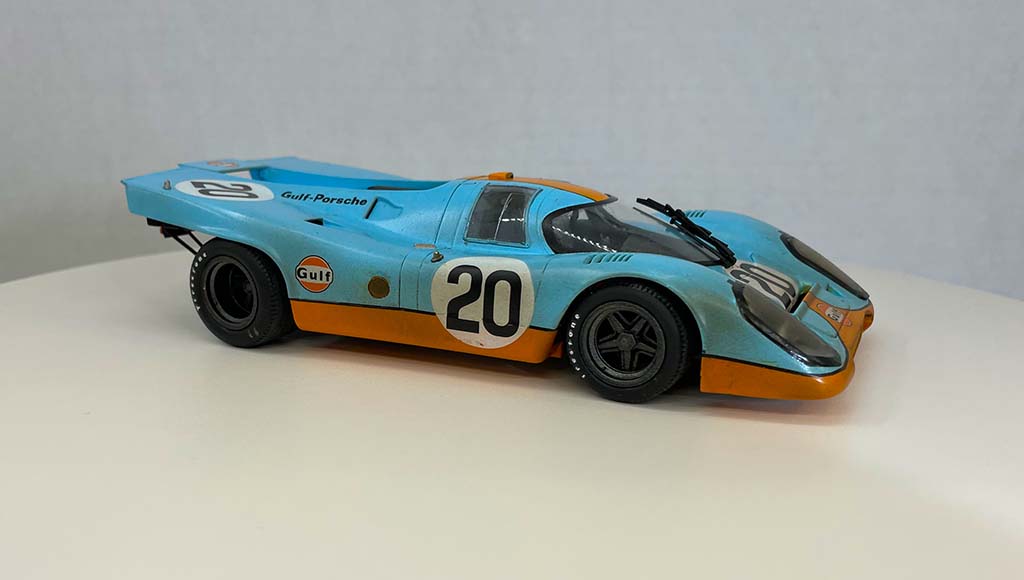



To see a video of the car on my turntable – go HERE.

